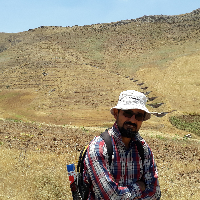Assessment of WaTEM/SEDEM model for water and tillage induced soil erosion (Case study: Sample sub catchment of Kachik-, Golestan Province)
Water and tillage-induced soil erosion on steep slopes farmlands are primary causes of land degradation process that gradually change land morphology. Measurement of soil erosion and sedimentation in most watersheds are nearly impossible. So soil erosion modelling and simulation to understand the processes of soil erosion, to predict runoff and soil erosion and also to determine the best management practices of soil conservation is highly important.
Area of study (Sample sub- catchment) is a sub-watershed of the Kachik watershed in Golestan province, which is one of the sub-basins of the Gorganroud basin. This area is around 197 ha which completely covered with fertile and erosive loess deposits and is a part of Iranian Loess Plateau (ILP). In this study, WaTEM / SEDEM version 2004 used to estimate water and tillage erosion. After soil sampling in 20 different location respected to the model based sampling method on minimax approach, 137Cs activity determined, and all three distinct erosion phases prepared. Finally, erosion map using 137Cs by considering conversion models including Mass Balance II for farmland and Diffusion and Migration for other land uses produced. Then the erosion and sediment point map produced separately for model evaluation.
Using 137Cs radionuclide, 90 % of the soil measurement locations devoted to erosion. Mean annual soil erosion using radionuclide conversion models was 21.1 ton ha-1. This rate of soil erosion regards to 97% SDR (Sediment Delivery Ratio) illustrates high potential for sediment production in the area of interest. Mean of water and tillage erosion by WaTEM/SEDEM were 8.28 and 4.87 ton ha-1 year-1 respectively in erosion locations and this rate for sediment was 18.14 and 7.89 ton ha-1 year-1 for sediment zones as well. Soil erosion and sedimentation rate using WaTEM/SEDEM model was estimated to be 1.46 and 0.85 ton ha-1 year-1 in turn. SDR for WaTEM/SEDEM in this study was around 58 %.
Given that the entire study area covered with sensitive and fertile loess deposits, and a significant percentage of area devoted to farmland, so water and tillage induced soil erosion is of great importance. The results of this research indicate a low estimation (under-estimation) of the WaTEM / SEDEM model compared to the actual values (measured 137Cs). As a result, WaTEM / SEDEM erosion model is not effective in the loess deposits of the northeast of Golestan province. On one hand spatial pattern of water and tillage induced soil erosion can be used in soil and water conservation practices. On the other hand, pertaining to large vast area devoted to farmland in Gorganrood Basin, tillage erosion should be taken by decision maker. Although for higher certainty, it is necessary to calibrate the model and repeat its implementation in other watersheds.
- حق عضویت دریافتی صرف حمایت از نشریات عضو و نگهداری، تکمیل و توسعه مگیران میشود.
- پرداخت حق اشتراک و دانلود مقالات اجازه بازنشر آن در سایر رسانههای چاپی و دیجیتال را به کاربر نمیدهد.




